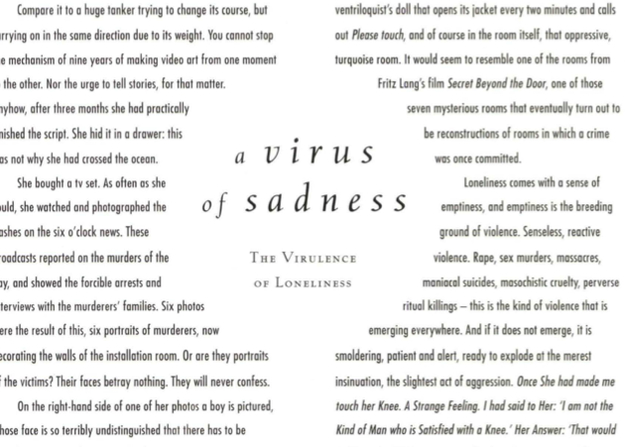Early in 1989 she left for New York. She would hove a studio at her disposal for one year, so she would be able to spend that year in 0 city that is both heaven and hell at the some time. It happened at just the right moment. She was fed up with mediocrity. She was sick and tired of the entire suffocating video business. She had better put an end to it. No more video.
Her flight over the ocean marked the beginning of liberation. For away from The Netherlands and Europe, she could devote herself to totally different work. However, 0 book that described New York os the metropolis where prostitution is omnipresent, violence contagious and loneliness radical, queered the pitch for her. It gave her ideas for 0 video script.
Compare it to a huge tanker trying to change its course, but carrying on in the same direction due to its weight. You cannot stop the mechanism of nine years of making video art from one moment to the other. Nor the urge to tell stories, for that matter. Anyhow, after three months she hod practically finished the script. She hid it in 0 drawer: this was not why she had crossed the ocean.
She bought a tv set. As often as she could, she watched and photographed the flashes on the six o'clock news. These broadcasts reported on the murders of the day, and showed the forcible arrests and interviews with the murderers' families. Six photos were the result of this, six portraits of murderers, now decorating the walls of the installation room. Or are they portraits of the victims? Their faces betray nothing. They will never confess.
On the right-hand side of one of her photos a boy is pictured, whose face is so terribly undistinguished that there has to be something wrong with it. It must be hiding something. However, the blue of the background does not reveal anything, it just accentuates the chilly indefiniteness of his appearance. The building on the left in the photo, quivering away into the night, also remains silent. Did he live there? Or work there? Could this be the scene of the crime? That might be deduced from the sadistic caption: / Pul my Arms around Her and pinned Her lo the Building... So apparently there is a 'her'. Is it a matter of love?
If the individual items on the photo hardly make us any the wiser, the totality reveals a certain loneliness. The loneliness of the murderer. That of the victim. The loneliness of the maker and that of the individual that cannot cope with the influencing forces of the media. It has nothing to do with the romantic feeling of abandonment and of feeling lost in a world that has become indifferent (alone-in-the-world). It is that radical and modern loneliness created by too much contact, by an overdose of channels and connections. The paradox that we are faced with is this: the urge to communicate produces loneliness.
This absurd kind of loneliness is not only revealed by the portraits. It reoccurs in all elements of the artist's installation A Virus of Sadness-, in the video-personal-ads to be found on the light green, transparent armchairs, in the ten tragi-comic clowns' heads, in the small round screenprints of averted heads and eyes, in the ventriloquist's doll that opens its jacket every two minutes and calls out Please touch, and of course in the room itself, that oppressive, turquoise room. It would seem to resemble one of the rooms from Fritz Lang's film Secret Beyond the Door, one of those seven mysterious rooms that eventually turn out to be reconstructions of rooms in which a crime was once committed.
Loneliness comes with a sense of emptiness, and emptiness is the breeding ground of violence. Senseless, reactive violence. Rape, sex murders, massacres, maniacal suicides, masochistic cruelty, perverse ritual killings - this is the kind of violence that is emerging everywhere. And if it does not emerge, it is smoldering, patient and alert, ready to explode at the merest insinuation, the slightest act of aggression. Once She had made me touch her Knee. A Strange Feeling. I had said to Her: 7 am not the Kind of Man who is Satisfied with a Knee.' Her Answer: 'That would be Disgusting!'This text is printed in large letters on one of her portraits. It does not take much imagination to know how this situation will end.
In contrast with her earlier installations, in which the objects and props more or less originated from the video tapes, the video images projected on the floor in A Virus of Sadness are only one of the many elements that give shape to the installation. Each element can be judged on its own merits, as each of them carries the virus of loneliness. And at the same time each element shows the symptoms of brute violence that can break loose at any moment in Lydia Schouten's turquoise murder room.
Mediamatic Magazine vol 5#1+2 1 Jan 1990
A virus of sadness
The Artists
The Virulence of Loneliness
